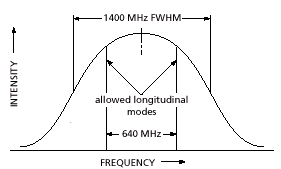 |
|
||||||
 |
Knowledge of Laser |
| Home > Knowledge Center > Knowledge of laser > Longitudinal Modes |
The output frequencies of a laser are determined by several factors. First, the gross wavelength is determined by the energy uncertainty (broadening) of the laser transition, which determines the wavelength and overall linewidth. Nonetheless, at any given instant, only a relatively few frequencies within this overall envelope are allowed to oscillate. These "longitudinal modes" result from the boundary conditions that, in a conventional two-mirror lasers, the amplitude of the wave must be zero at the mirror surface (i.e., that the oscillating wave is a standing wave). This means only those laser frequencies that meet the criteria n = Nc/2L can operate, where c is the speed of light, L is the effective cavity length, and N is an interger. Adjacent modes are typically orthogonally polarized. The illustration below shows the lasing envelope of a helium neon laser operating at 632.8nm with a cavity spacing of 23cm. This results in a mode spacing of 640MHz. Since the width of the gain curve (FWHM) is only 1400MHz, only two longitudinal modes can operate at any given time. If the laser were twice as long, four longitudinal modes could operate simultaneously
Since the allowable longitudinal modes are a function of cavity length, the frequency will change as the cavity length changes. In lasers where only a few longitudinal modes can operate, these changes will cause outpout power to fluctuate as the modes sweep under the gain curve.
|
||||||||||
